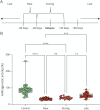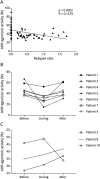Serum Levels of Aryl Hydrocarbon Receptor Plasma Agonist Activity Are Reduced in Patients With NMOSD and Correlate With Disease Activity
- PMID: 40763318
- PMCID: PMC12363339
- DOI: 10.1212/NXI.0000000000200457
Serum Levels of Aryl Hydrocarbon Receptor Plasma Agonist Activity Are Reduced in Patients With NMOSD and Correlate With Disease Activity
Abstract
Background and objectives: Neuromyelitis optica spectrum disorders (NMOSDs) are severe autoimmune diseases characterized by recurrent CNS inflammation and high risk of persistent disability. Effective disease monitoring is essential for timely intervention and relapse prevention. While biomarkers such as soluble glial fibrillary acidic protein and neurofilament light chain indicate astrocytic and neuronal damage, additional markers are needed to improve disease monitoring and treatment strategies. The ligand-activated transcription factor aryl hydrocarbon receptor (AHR) is a key immune regulator in autoimmune diseases such as multiple sclerosis, where its ligands correlate with disease activity. Given overlapping immunologic pathways, AHR signaling may also influence NMOSD pathophysiology. In this context, this study examines serum levels of AHR ligand in NMOSD, assessing their regulation and association with disease activity. Elucidating the role of AHR signaling may pave the way to explore novel markers of disease activity and therapeutic intervention in NMOSD.
Methods: AHR agonistic activity was assessed in the serum of 102 patients with aquaporin-4 antibody-positive NMOSD across various stages of the disease. As control, serum samples from 36 patients with noninflammatory diseases were evaluated for AHR agonistic activity. In addition, we measured AHR activity longitudinally in 10 individuals at 3 distinct time points-during a quiescent phase preceding relapse, at relapse, and during a postrelapse quiescent phase-to evaluate the dynamic changes in AHR activity over time.
Results: Serum AHR agonistic activity was globally decreased in the NMOSD cohort compared with the control group. AHR agonistic activity was further reduced during or near relapses. Finally, we conducted longitudinal analyses on individual serum samples obtained from patients with NMOSD. Our findings reveal that AHR activity significantly decreases during the relapse phase compared with the quiescent phase, with a subsequent recovery after relapse.
Discussion: Serum AHR agonistic activity is reduced in patients with NMOSD compared with controls and further modulated in temporal vicinity to a relapse. Furthermore, our longitudinal analysis confirmed that AHR activity is markedly reduced during relapse, underscoring its dynamic modulation in relation to disease activity. AHR agonist activity might represent a potential tool to monitor disease activity and develop novel therapeutic strategies.
Classification of evidence: This study provides Class III evidence that serum levels of AHR agonistic activity are reduced in patients with NMOSD compared with noninflammatory controls, and that these levels are further modulated across different stages of the disease.
Conflict of interest statement
The authors report no relevant disclosures. Go to
Figures



References
-
- Aktas O, Hartung HP, Smith MA, et al. Serum neurofilament light chain levels at attack predict post-attack disability worsening and are mitigated by inebilizumab: analysis of four potential biomarkers in neuromyelitis optica spectrum disorder. J Neurol Neurosurg Psychiatry. 2023;94(9):757-768. doi: 10.1136/jnnp-2022-330412 - DOI - PMC - PubMed
MeSH terms
Substances
LinkOut - more resources
Full Text Sources
Research Materials
